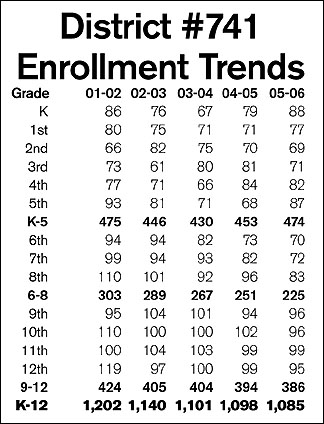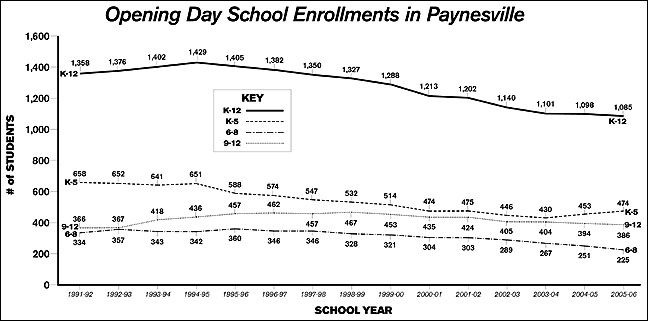Stable enrollment pleasant surprise
to school district again
Two years of nearly stable opening-day enrollments - the district lost only three students last year - provides hope that the district's decade-long enrollment decline might be coming to an end. This year's enrollment, while down, was 13 students more than the district had projected.
"We're pretty pleased with our opening-day enrollment," said superintendent Todd Burlingame. "We hope it stays that way."
Student enrollment has been dropping since it peaked at 1,429 in 1994-95. But, for the first nine years of this decline, the average student loss was 36 per year, and the district faced large opening-day enrollment drops of 75 students in 2000-01 and 62 students in 2002-03. In the last two years, the district's opening-day enrollment has dropped only 16 total or eight students per year.
The prime cause again this year was graduating a larger class than its replacement in kindergarten. The district lost 99 seniors from last year due to graduation, who were replaced by only 88 kindergartners this fall, a net loss of 11.
 While losing 99 seniors and getting only 88 kindergartners still represents an enrollment decline, it is the best the district has done in nearly a decade. Since 1994-95, the district has graduated more seniors every year than its next kindergarten class. (In 1994, the district graduated 92 seniors, while the 1994-95 kindergarten class was 106, which is the last time the district had an opening-day enrollment increase.)
While losing 99 seniors and getting only 88 kindergartners still represents an enrollment decline, it is the best the district has done in nearly a decade. Since 1994-95, the district has graduated more seniors every year than its next kindergarten class. (In 1994, the district graduated 92 seniors, while the 1994-95 kindergarten class was 106, which is the last time the district had an opening-day enrollment increase.)
Since 1994-95, the district has averaged graduating 105 seniors per year while replacing them with an average kindergarten class of 80. That loss of roughly 25 students to graduation per year accounts for 80 percent of the district's enrollment decline over that time.
This year's 88-student kindergarten class not only tops the average size for kindergarten classes over the past decade, but it is the first kindergarten class to have 80 or more students in four years.
That kindergarten class was "good to see," said Burlingame. "It's nice to see our numbers come up again in the lower grades," he said.
Should the district start averaging kindergarten classes of 90, the enrollment decline in the district would soon end. The district has projected that its enrollment may be headed towards 1,000 (75 students per grade K-12), rather than 1,300-plus when the district had 100 students per grade.
For the opening day of the 2005-06 school year, the district averages 79 students per grade at Paynesville Area Elementary School, 75 students per grade at Paynesville Area Middle School, and 96 students per grade at Paynesville Area High School.
This year, likely for the first time since the 1960s, the district does not have a grade with more than 100 students. Its largest class this year on the first day was the 99-member junior class.
While this reflects the enrollment decline over the past decade, it could mean that future enrollments could hold steady. Next year, for example, if the district has another class of close to 90 in kindergarten, it could lose less than ten students after graduating 95 seniors.
Its too early to tell how much this stronger enrollment will affect the district's budget, said Burlingame, but it is good news. Since the school district is paid on a per-pupil basis by the state, more students mean more revenue from the state. But, the state does not finalize its school aid until the district's daily enrollment throughout the year is compiled next summer. The district gets its main revenue from the state based on its enrollment throughout the year, not just on opening day.
District officials are currently working on the annual audit, which they expect to be better than budgeted. Once this is completed later this fall, the district should be able to revise its current budget and project budget reductions for next year.
The district will still need to reduce its spending to account for its declining student enrollment. Any budget cuts should continue to be focused at the middle and high schools, since this is where larger grades are now being replaced by smaller ones. Enrollment at both the middle school and high school dropped this fall.
On the other hand, the smaller grades have now all passed through the elementary school - which was the target of cuts when these smaller classes arrived. Now, though, for the second straight year, enrollment at the elementary school has increased, due to a larger kindergarten class replacing a smaller class of fifth graders from last year (the current sixth graders).
Burlingame hopes to be able to continue to do any reductions through retirement and attrition.
Right now, the district is projecting a deficit budget of $354,751 for 2005-06, but this is a worst-case scenario, according to district officials. It is based on the student enrollment projections (which were higher than projected on opening day), and it does not include the four-percent funding increase from the state (which should mean $226,000 for the school district this year).
But the district also has to negotiate new contracts with the teachers and staff, and currently only has inflationary estimates for these new contracts in the budget. The district also faces expenses over which it has no control, said Burlingame, such as high fuel costs (diesel for buses and natural gas for heating).
The district has set a goal to have an eight percent balance in its general fund - to cover one month of expenses - which would be over $700,000. In the 2003-04 school year, which ran from July 2003 to June 2004 and is the last for which the district has audited numbers, the district had an operating margin of $301,353, which raised the district's general fund balance to $562,206, as of July 1, 2004, the highest for the district since July 1998.

Contact the author at editor@paynesvillepress.com • Return to News Menu
Home | Marketplace | Community